Computer Systems Architecture Report: OSI and TCP/IP Models Analysis
VerifiedAdded on 2022/12/30
|9
|2001
|5
Report
AI Summary
This report delves into the intricacies of computer systems architecture, providing a comprehensive overview of various key components and concepts. It begins with an introduction to computer systems and their functions, followed by an analysis of hardware and networking elements, including the relationship between hardware and network addresses, and a comparison of physical and logical networking topologies. The report then explores the OSI and TCP/IP models, outlining their layers and functionalities. Furthermore, it discusses diagnostic and troubleshooting skills, as well as essential maintenance activities for computer systems. The report concludes by summarizing the key findings and emphasizing the importance of understanding computer systems architecture in the current technological landscape. The report also provides references to relevant books and journals to support the analysis.
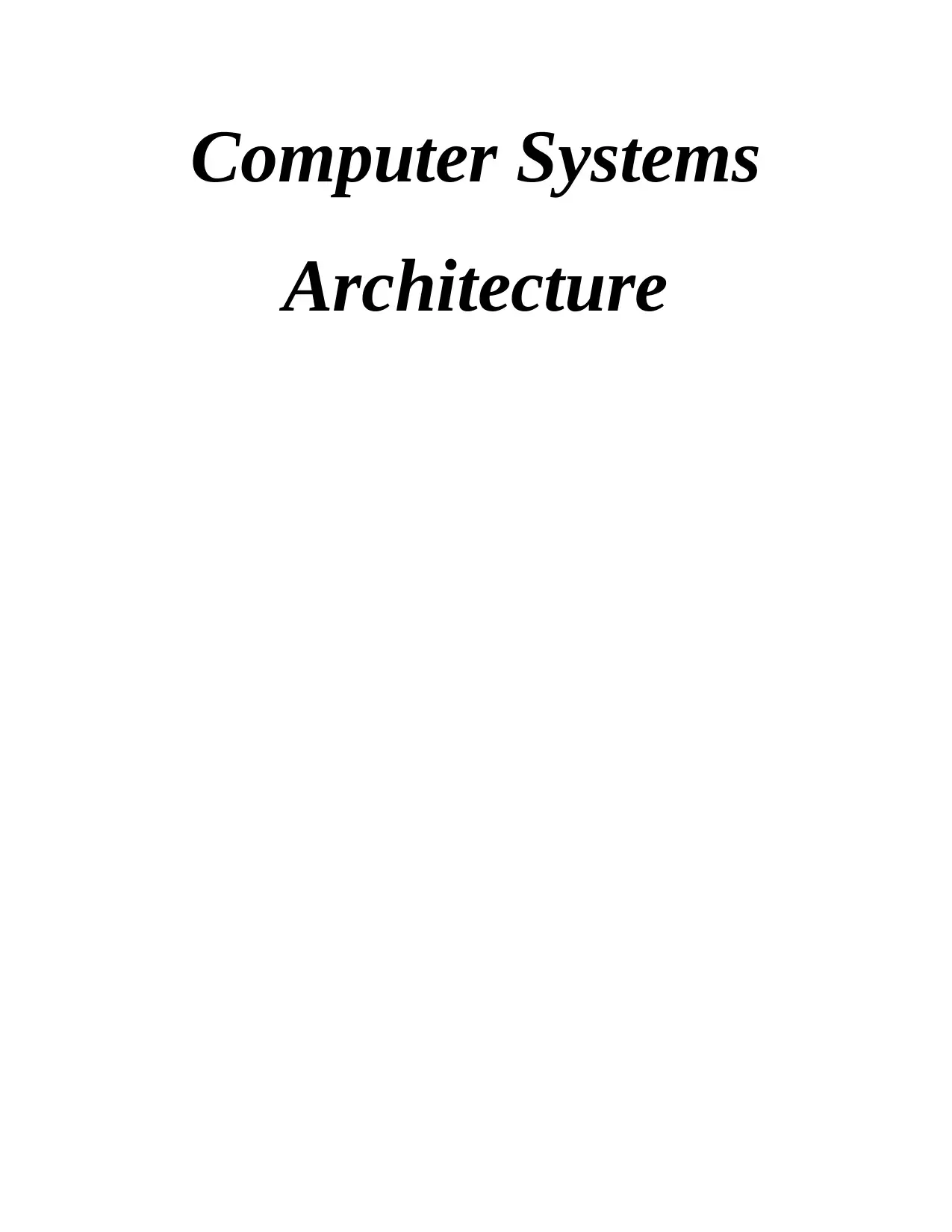
Computer Systems
Architecture
Architecture
Paraphrase This Document
Need a fresh take? Get an instant paraphrase of this document with our AI Paraphraser
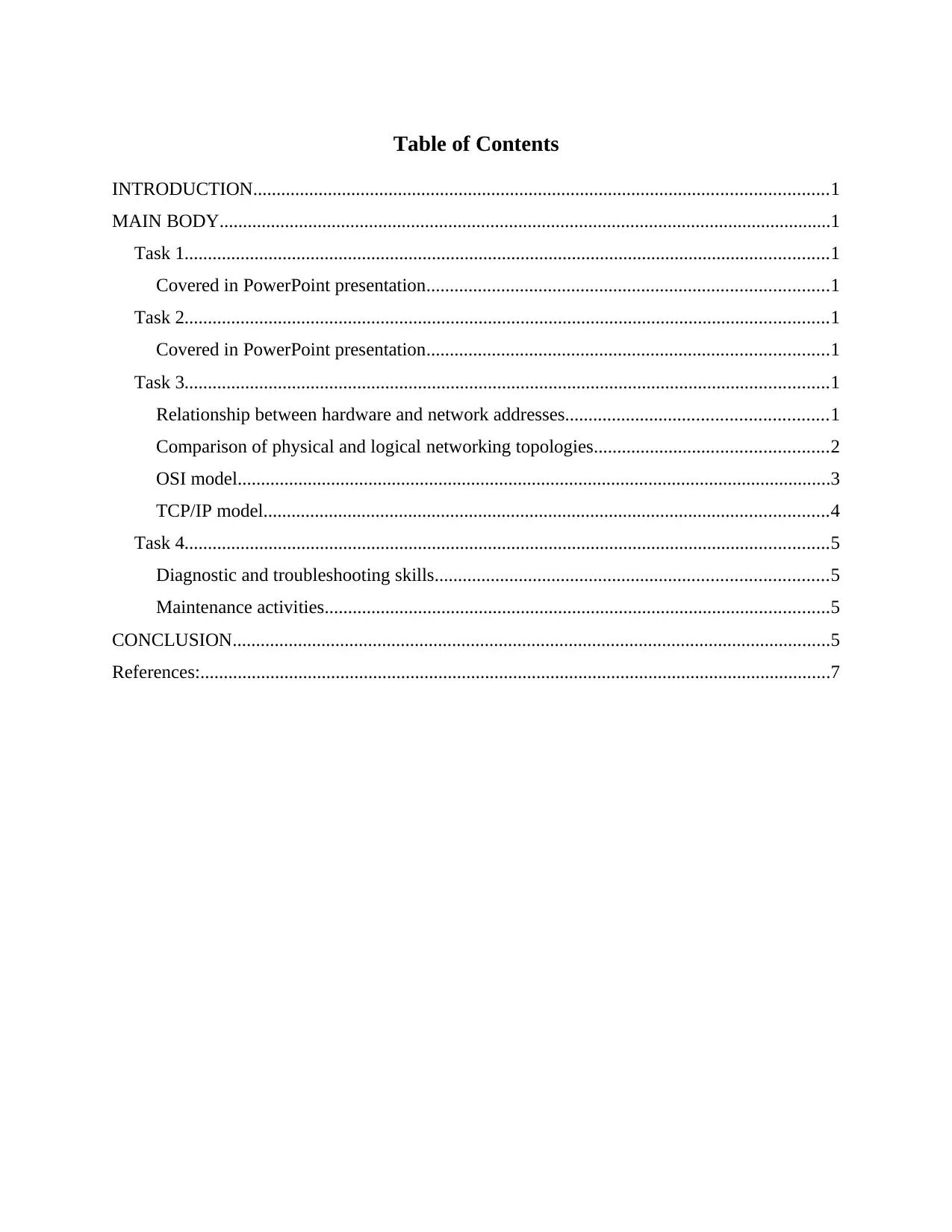
Table of Contents
INTRODUCTION...........................................................................................................................1
MAIN BODY...................................................................................................................................1
Task 1..........................................................................................................................................1
Covered in PowerPoint presentation......................................................................................1
Task 2..........................................................................................................................................1
Covered in PowerPoint presentation......................................................................................1
Task 3..........................................................................................................................................1
Relationship between hardware and network addresses........................................................1
Comparison of physical and logical networking topologies..................................................2
OSI model...............................................................................................................................3
TCP/IP model.........................................................................................................................4
Task 4..........................................................................................................................................5
Diagnostic and troubleshooting skills....................................................................................5
Maintenance activities............................................................................................................5
CONCLUSION................................................................................................................................5
References:.......................................................................................................................................7
INTRODUCTION...........................................................................................................................1
MAIN BODY...................................................................................................................................1
Task 1..........................................................................................................................................1
Covered in PowerPoint presentation......................................................................................1
Task 2..........................................................................................................................................1
Covered in PowerPoint presentation......................................................................................1
Task 3..........................................................................................................................................1
Relationship between hardware and network addresses........................................................1
Comparison of physical and logical networking topologies..................................................2
OSI model...............................................................................................................................3
TCP/IP model.........................................................................................................................4
Task 4..........................................................................................................................................5
Diagnostic and troubleshooting skills....................................................................................5
Maintenance activities............................................................................................................5
CONCLUSION................................................................................................................................5
References:.......................................................................................................................................7
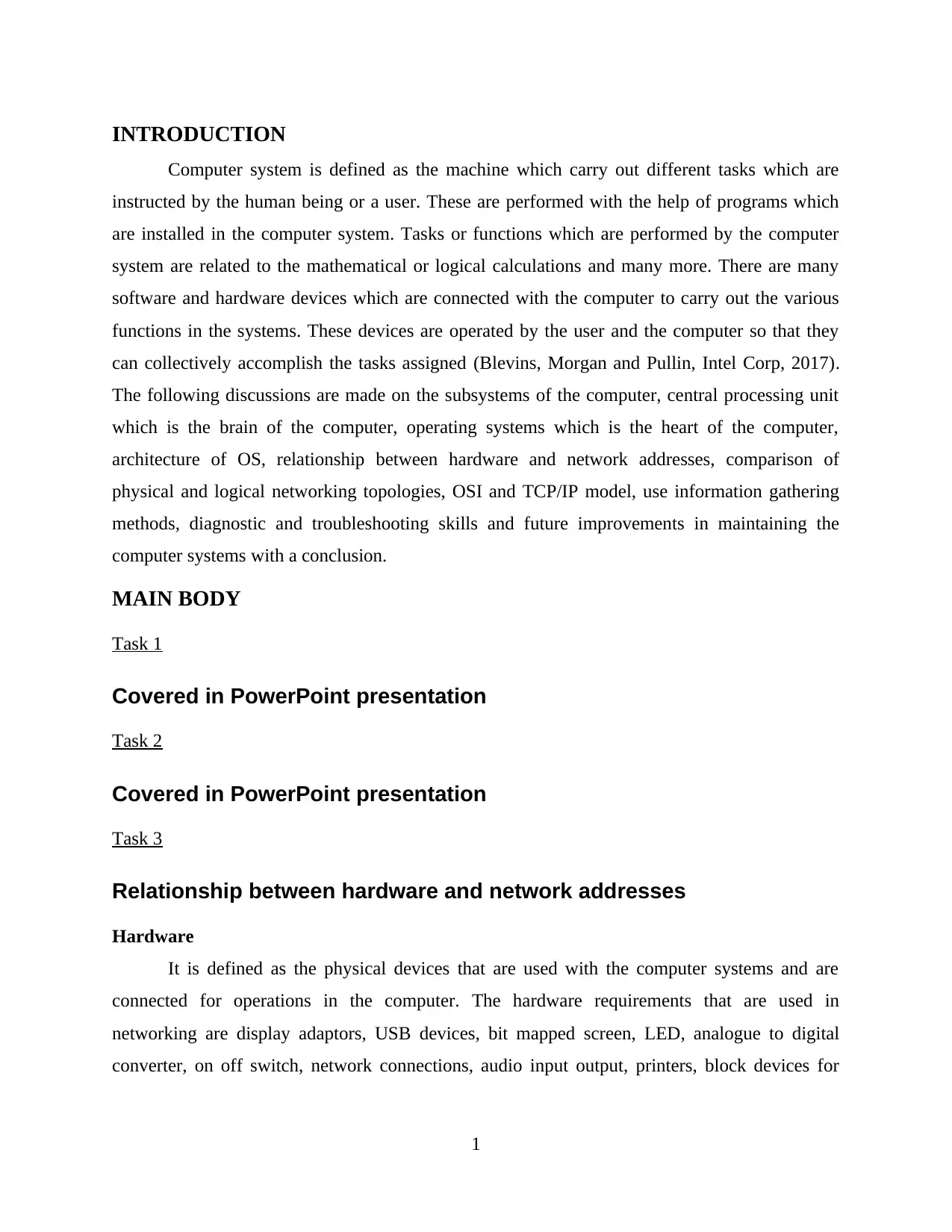
INTRODUCTION
Computer system is defined as the machine which carry out different tasks which are
instructed by the human being or a user. These are performed with the help of programs which
are installed in the computer system. Tasks or functions which are performed by the computer
system are related to the mathematical or logical calculations and many more. There are many
software and hardware devices which are connected with the computer to carry out the various
functions in the systems. These devices are operated by the user and the computer so that they
can collectively accomplish the tasks assigned (Blevins, Morgan and Pullin, Intel Corp, 2017).
The following discussions are made on the subsystems of the computer, central processing unit
which is the brain of the computer, operating systems which is the heart of the computer,
architecture of OS, relationship between hardware and network addresses, comparison of
physical and logical networking topologies, OSI and TCP/IP model, use information gathering
methods, diagnostic and troubleshooting skills and future improvements in maintaining the
computer systems with a conclusion.
MAIN BODY
Task 1
Covered in PowerPoint presentation
Task 2
Covered in PowerPoint presentation
Task 3
Relationship between hardware and network addresses
Hardware
It is defined as the physical devices that are used with the computer systems and are
connected for operations in the computer. The hardware requirements that are used in
networking are display adaptors, USB devices, bit mapped screen, LED, analogue to digital
converter, on off switch, network connections, audio input output, printers, block devices for
1
Computer system is defined as the machine which carry out different tasks which are
instructed by the human being or a user. These are performed with the help of programs which
are installed in the computer system. Tasks or functions which are performed by the computer
system are related to the mathematical or logical calculations and many more. There are many
software and hardware devices which are connected with the computer to carry out the various
functions in the systems. These devices are operated by the user and the computer so that they
can collectively accomplish the tasks assigned (Blevins, Morgan and Pullin, Intel Corp, 2017).
The following discussions are made on the subsystems of the computer, central processing unit
which is the brain of the computer, operating systems which is the heart of the computer,
architecture of OS, relationship between hardware and network addresses, comparison of
physical and logical networking topologies, OSI and TCP/IP model, use information gathering
methods, diagnostic and troubleshooting skills and future improvements in maintaining the
computer systems with a conclusion.
MAIN BODY
Task 1
Covered in PowerPoint presentation
Task 2
Covered in PowerPoint presentation
Task 3
Relationship between hardware and network addresses
Hardware
It is defined as the physical devices that are used with the computer systems and are
connected for operations in the computer. The hardware requirements that are used in
networking are display adaptors, USB devices, bit mapped screen, LED, analogue to digital
converter, on off switch, network connections, audio input output, printers, block devices for
1
⊘ This is a preview!⊘
Do you want full access?
Subscribe today to unlock all pages.

Trusted by 1+ million students worldwide

block data transfer, hard disks, cameras, character devices used to receiving and sending the the
single characters of the information across the network.
Networking
There are various elements which are used to install a network or make a usage of it.
These varies from network to network that are created for a specific purpose with a special
features. Main hardware part which are highly required in it are cable, hub, switch, network
interface card, modem, connectors, servers and router. Therefore, the usage of various network
nodes and the variety of hardware devices are in the relationship with the networking and the
hardware which shows that not only the software are important for networking, hardware is
equally essential in implementation of the networking topologies (Pelc and Galus, 2017).
Comparison of physical and logical networking topologies
Basis Physical topology Logical topology
Meaning It is referred to the network
and focuses on how it looks
and function, that is all the
physical nature of the network
topology which it consist for
it's operations.
It is referred to the network
and focuses on the fashion that
how the data travels across the
network, what fashion they are
adopting in travelling and how
logistically it travels.
Types It is of various type through
which network formation is
done in a particular
organization or of personal use
as well. It's types are bus, star,
ring and mesh topologies.
It is also of variety of types
through which the network is
formed logically in an
organization or of personal
use. It's types are logical bus
and the logical ring (Penney
and Chen, 2019).
Connections Networks connected
physically here with the help
of variety of cables and
different types of devices that
Networks connected logically
here with the help of data
which travels through the
network from one node to the
2
single characters of the information across the network.
Networking
There are various elements which are used to install a network or make a usage of it.
These varies from network to network that are created for a specific purpose with a special
features. Main hardware part which are highly required in it are cable, hub, switch, network
interface card, modem, connectors, servers and router. Therefore, the usage of various network
nodes and the variety of hardware devices are in the relationship with the networking and the
hardware which shows that not only the software are important for networking, hardware is
equally essential in implementation of the networking topologies (Pelc and Galus, 2017).
Comparison of physical and logical networking topologies
Basis Physical topology Logical topology
Meaning It is referred to the network
and focuses on how it looks
and function, that is all the
physical nature of the network
topology which it consist for
it's operations.
It is referred to the network
and focuses on the fashion that
how the data travels across the
network, what fashion they are
adopting in travelling and how
logistically it travels.
Types It is of various type through
which network formation is
done in a particular
organization or of personal use
as well. It's types are bus, star,
ring and mesh topologies.
It is also of variety of types
through which the network is
formed logically in an
organization or of personal
use. It's types are logical bus
and the logical ring (Penney
and Chen, 2019).
Connections Networks connected
physically here with the help
of variety of cables and
different types of devices that
Networks connected logically
here with the help of data
which travels through the
network from one node to the
2
Paraphrase This Document
Need a fresh take? Get an instant paraphrase of this document with our AI Paraphraser
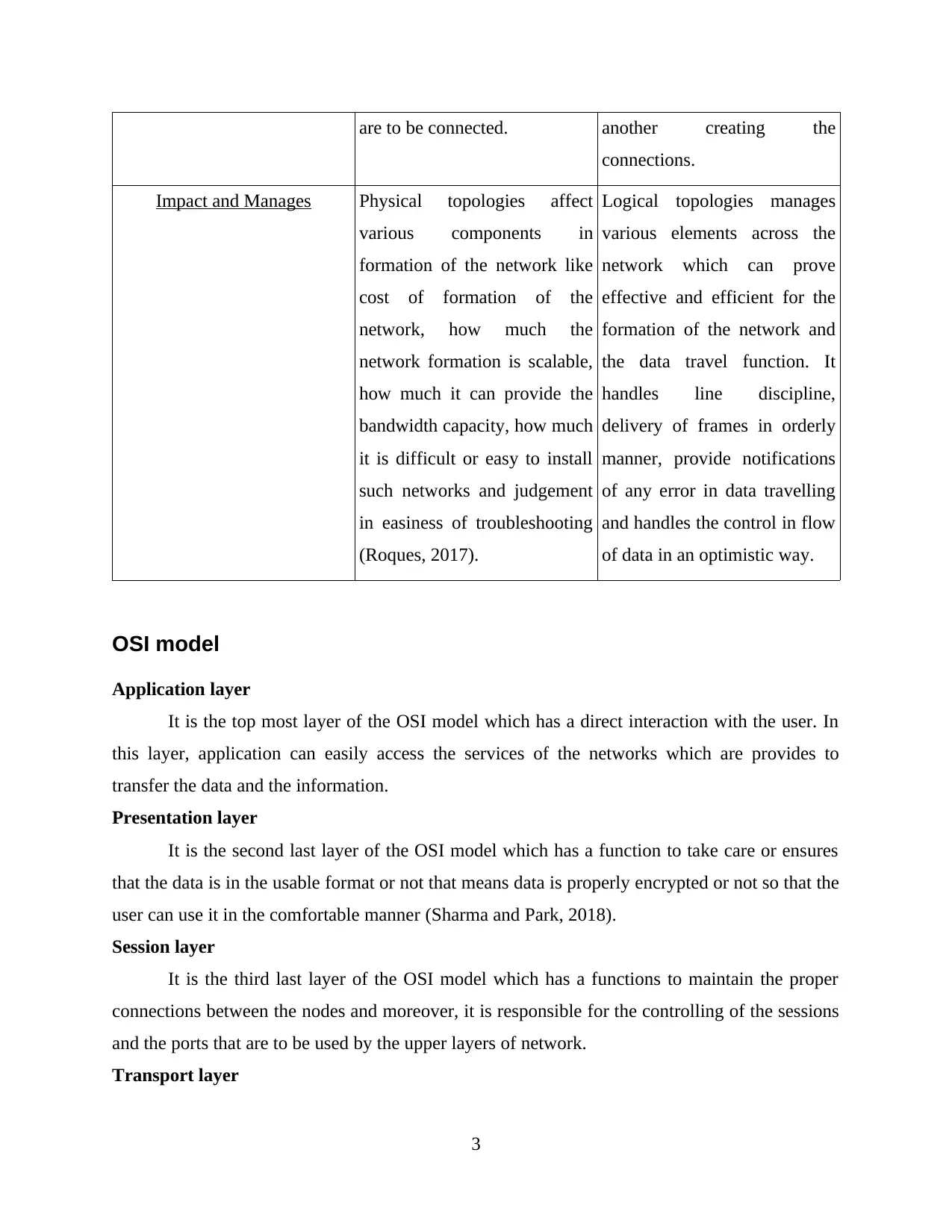
are to be connected. another creating the
connections.
Impact and Manages Physical topologies affect
various components in
formation of the network like
cost of formation of the
network, how much the
network formation is scalable,
how much it can provide the
bandwidth capacity, how much
it is difficult or easy to install
such networks and judgement
in easiness of troubleshooting
(Roques, 2017).
Logical topologies manages
various elements across the
network which can prove
effective and efficient for the
formation of the network and
the data travel function. It
handles line discipline,
delivery of frames in orderly
manner, provide notifications
of any error in data travelling
and handles the control in flow
of data in an optimistic way.
OSI model
Application layer
It is the top most layer of the OSI model which has a direct interaction with the user. In
this layer, application can easily access the services of the networks which are provides to
transfer the data and the information.
Presentation layer
It is the second last layer of the OSI model which has a function to take care or ensures
that the data is in the usable format or not that means data is properly encrypted or not so that the
user can use it in the comfortable manner (Sharma and Park, 2018).
Session layer
It is the third last layer of the OSI model which has a functions to maintain the proper
connections between the nodes and moreover, it is responsible for the controlling of the sessions
and the ports that are to be used by the upper layers of network.
Transport layer
3
connections.
Impact and Manages Physical topologies affect
various components in
formation of the network like
cost of formation of the
network, how much the
network formation is scalable,
how much it can provide the
bandwidth capacity, how much
it is difficult or easy to install
such networks and judgement
in easiness of troubleshooting
(Roques, 2017).
Logical topologies manages
various elements across the
network which can prove
effective and efficient for the
formation of the network and
the data travel function. It
handles line discipline,
delivery of frames in orderly
manner, provide notifications
of any error in data travelling
and handles the control in flow
of data in an optimistic way.
OSI model
Application layer
It is the top most layer of the OSI model which has a direct interaction with the user. In
this layer, application can easily access the services of the networks which are provides to
transfer the data and the information.
Presentation layer
It is the second last layer of the OSI model which has a function to take care or ensures
that the data is in the usable format or not that means data is properly encrypted or not so that the
user can use it in the comfortable manner (Sharma and Park, 2018).
Session layer
It is the third last layer of the OSI model which has a functions to maintain the proper
connections between the nodes and moreover, it is responsible for the controlling of the sessions
and the ports that are to be used by the upper layers of network.
Transport layer
3
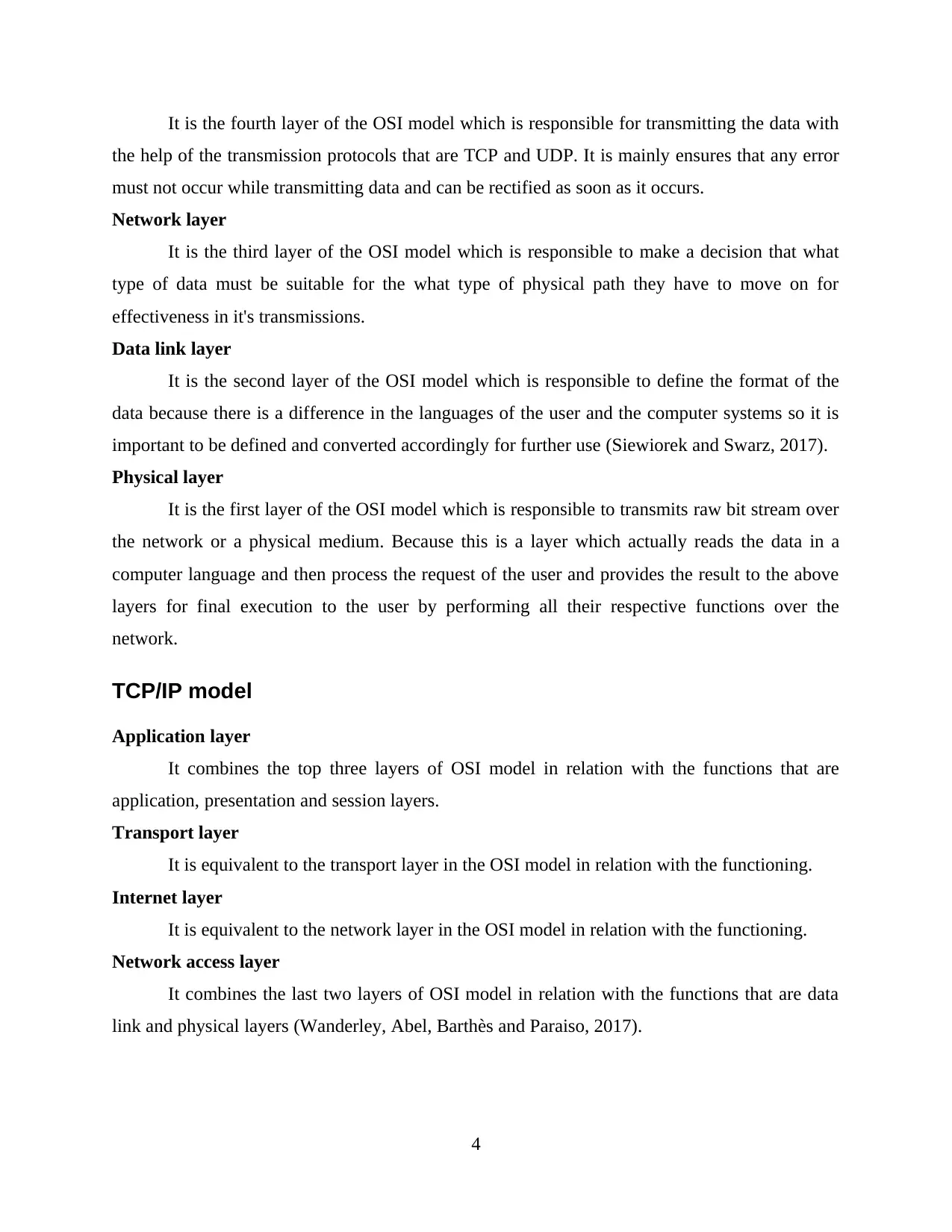
It is the fourth layer of the OSI model which is responsible for transmitting the data with
the help of the transmission protocols that are TCP and UDP. It is mainly ensures that any error
must not occur while transmitting data and can be rectified as soon as it occurs.
Network layer
It is the third layer of the OSI model which is responsible to make a decision that what
type of data must be suitable for the what type of physical path they have to move on for
effectiveness in it's transmissions.
Data link layer
It is the second layer of the OSI model which is responsible to define the format of the
data because there is a difference in the languages of the user and the computer systems so it is
important to be defined and converted accordingly for further use (Siewiorek and Swarz, 2017).
Physical layer
It is the first layer of the OSI model which is responsible to transmits raw bit stream over
the network or a physical medium. Because this is a layer which actually reads the data in a
computer language and then process the request of the user and provides the result to the above
layers for final execution to the user by performing all their respective functions over the
network.
TCP/IP model
Application layer
It combines the top three layers of OSI model in relation with the functions that are
application, presentation and session layers.
Transport layer
It is equivalent to the transport layer in the OSI model in relation with the functioning.
Internet layer
It is equivalent to the network layer in the OSI model in relation with the functioning.
Network access layer
It combines the last two layers of OSI model in relation with the functions that are data
link and physical layers (Wanderley, Abel, Barthès and Paraiso, 2017).
4
the help of the transmission protocols that are TCP and UDP. It is mainly ensures that any error
must not occur while transmitting data and can be rectified as soon as it occurs.
Network layer
It is the third layer of the OSI model which is responsible to make a decision that what
type of data must be suitable for the what type of physical path they have to move on for
effectiveness in it's transmissions.
Data link layer
It is the second layer of the OSI model which is responsible to define the format of the
data because there is a difference in the languages of the user and the computer systems so it is
important to be defined and converted accordingly for further use (Siewiorek and Swarz, 2017).
Physical layer
It is the first layer of the OSI model which is responsible to transmits raw bit stream over
the network or a physical medium. Because this is a layer which actually reads the data in a
computer language and then process the request of the user and provides the result to the above
layers for final execution to the user by performing all their respective functions over the
network.
TCP/IP model
Application layer
It combines the top three layers of OSI model in relation with the functions that are
application, presentation and session layers.
Transport layer
It is equivalent to the transport layer in the OSI model in relation with the functioning.
Internet layer
It is equivalent to the network layer in the OSI model in relation with the functioning.
Network access layer
It combines the last two layers of OSI model in relation with the functions that are data
link and physical layers (Wanderley, Abel, Barthès and Paraiso, 2017).
4
⊘ This is a preview!⊘
Do you want full access?
Subscribe today to unlock all pages.

Trusted by 1+ million students worldwide
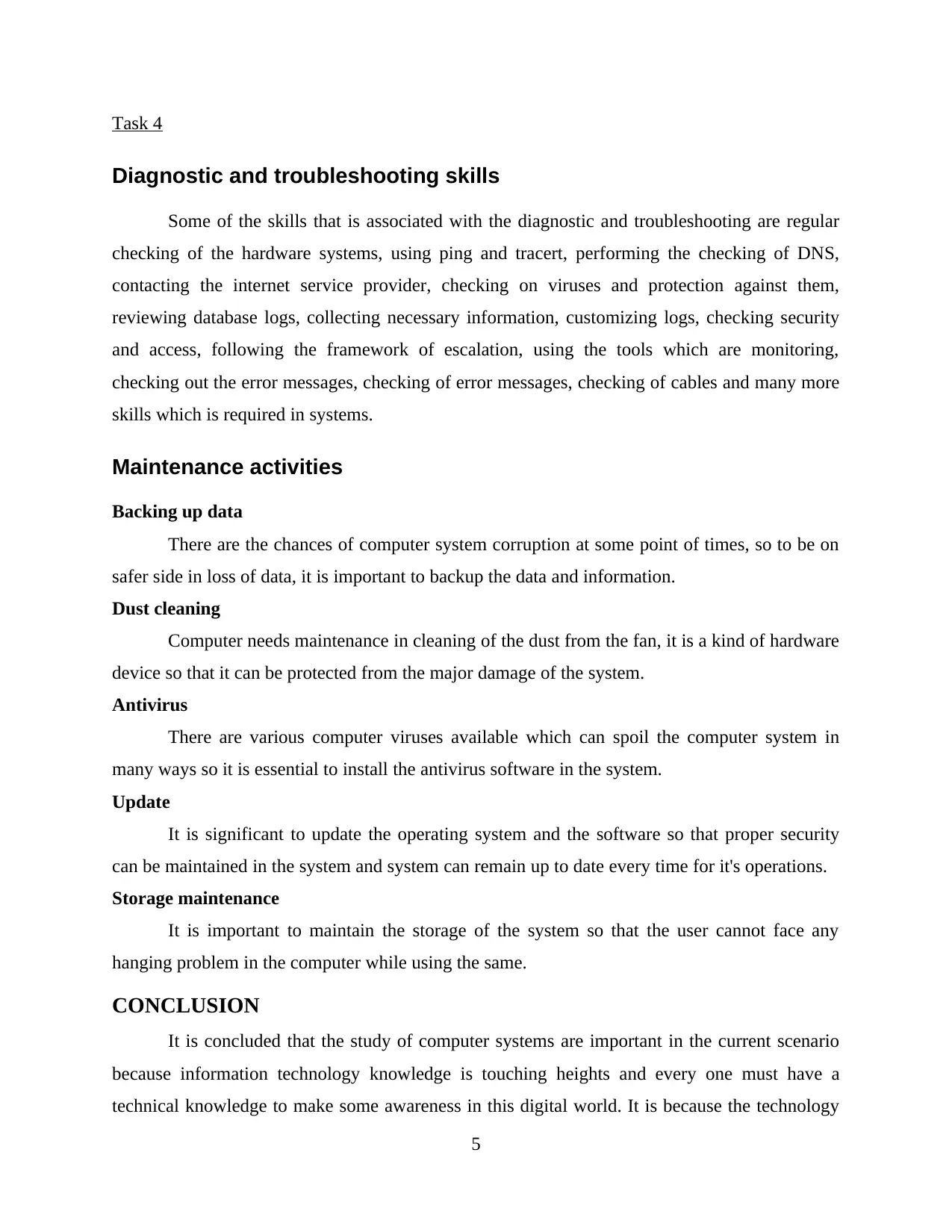
Task 4
Diagnostic and troubleshooting skills
Some of the skills that is associated with the diagnostic and troubleshooting are regular
checking of the hardware systems, using ping and tracert, performing the checking of DNS,
contacting the internet service provider, checking on viruses and protection against them,
reviewing database logs, collecting necessary information, customizing logs, checking security
and access, following the framework of escalation, using the tools which are monitoring,
checking out the error messages, checking of error messages, checking of cables and many more
skills which is required in systems.
Maintenance activities
Backing up data
There are the chances of computer system corruption at some point of times, so to be on
safer side in loss of data, it is important to backup the data and information.
Dust cleaning
Computer needs maintenance in cleaning of the dust from the fan, it is a kind of hardware
device so that it can be protected from the major damage of the system.
Antivirus
There are various computer viruses available which can spoil the computer system in
many ways so it is essential to install the antivirus software in the system.
Update
It is significant to update the operating system and the software so that proper security
can be maintained in the system and system can remain up to date every time for it's operations.
Storage maintenance
It is important to maintain the storage of the system so that the user cannot face any
hanging problem in the computer while using the same.
CONCLUSION
It is concluded that the study of computer systems are important in the current scenario
because information technology knowledge is touching heights and every one must have a
technical knowledge to make some awareness in this digital world. It is because the technology
5
Diagnostic and troubleshooting skills
Some of the skills that is associated with the diagnostic and troubleshooting are regular
checking of the hardware systems, using ping and tracert, performing the checking of DNS,
contacting the internet service provider, checking on viruses and protection against them,
reviewing database logs, collecting necessary information, customizing logs, checking security
and access, following the framework of escalation, using the tools which are monitoring,
checking out the error messages, checking of error messages, checking of cables and many more
skills which is required in systems.
Maintenance activities
Backing up data
There are the chances of computer system corruption at some point of times, so to be on
safer side in loss of data, it is important to backup the data and information.
Dust cleaning
Computer needs maintenance in cleaning of the dust from the fan, it is a kind of hardware
device so that it can be protected from the major damage of the system.
Antivirus
There are various computer viruses available which can spoil the computer system in
many ways so it is essential to install the antivirus software in the system.
Update
It is significant to update the operating system and the software so that proper security
can be maintained in the system and system can remain up to date every time for it's operations.
Storage maintenance
It is important to maintain the storage of the system so that the user cannot face any
hanging problem in the computer while using the same.
CONCLUSION
It is concluded that the study of computer systems are important in the current scenario
because information technology knowledge is touching heights and every one must have a
technical knowledge to make some awareness in this digital world. It is because the technology
5
Paraphrase This Document
Need a fresh take? Get an instant paraphrase of this document with our AI Paraphraser

is upgrading day by day so it is essential to focus on the basic technical learnings. Therefore in
order to gather the deep information regarding such concepts of computer systems architecture,
this report covers the analysis of subsystems of the computer and central processing unit with
their connections and operations, examining operating systems and it's architecture with their
ranges and features, interpreting relationships and comparisons of hardware, network and
networking topologies, determining various models like OSI and TCP/IP models and observing
various information gathering methods with diagnostic and troubleshooting skills followed by
the future improvements in the maintenance of the computer systems. All such things studied in
the report are for better learnings, knowledge and execution of information technology in this
real time world.
6
order to gather the deep information regarding such concepts of computer systems architecture,
this report covers the analysis of subsystems of the computer and central processing unit with
their connections and operations, examining operating systems and it's architecture with their
ranges and features, interpreting relationships and comparisons of hardware, network and
networking topologies, determining various models like OSI and TCP/IP models and observing
various information gathering methods with diagnostic and troubleshooting skills followed by
the future improvements in the maintenance of the computer systems. All such things studied in
the report are for better learnings, knowledge and execution of information technology in this
real time world.
6

References:
Books and Journals
Blevins, D.F., Morgan, J.M. and Pullin, E.J., Intel Corp, 2017. Computer architecture to provide
flexibility and/or scalability. U.S. Patent 9,792,243.
Pelc, M. and Galus, D., 2017. Adaptation architecture for self-healing computer
systems. International Journal of Software Engineering and Knowledge
Engineering. 27(05). pp.791-815.
Penney, D.D. and Chen, L., 2019. A survey of machine learning applied to computer architecture
design. arXiv preprint arXiv:1909.12373.
Roques, P., 2017. Systems Architecture Modeling with the Arcadia Method: A Practical Guide to
Capella. Elsevier.
Sharma, P.K. and Park, J.H., 2018. Blockchain based hybrid network architecture for the smart
city. Future Generation Computer Systems, 86, pp.650-655.
Siewiorek, D. and Swarz, R., 2017. Reliable computer systems: design and evaluatuion. Digital
Press.
Wanderley, G.M.P., Abel, M.H., Barthès, J.P. and Paraiso, E.C., 2017, April. A system of
systems architecture for supporting decision-making. In 2017 IEEE 21st International
Conference on Computer Supported Cooperative Work in Design (CSCWD) (pp. 186-
191). IEEE.
7
Books and Journals
Blevins, D.F., Morgan, J.M. and Pullin, E.J., Intel Corp, 2017. Computer architecture to provide
flexibility and/or scalability. U.S. Patent 9,792,243.
Pelc, M. and Galus, D., 2017. Adaptation architecture for self-healing computer
systems. International Journal of Software Engineering and Knowledge
Engineering. 27(05). pp.791-815.
Penney, D.D. and Chen, L., 2019. A survey of machine learning applied to computer architecture
design. arXiv preprint arXiv:1909.12373.
Roques, P., 2017. Systems Architecture Modeling with the Arcadia Method: A Practical Guide to
Capella. Elsevier.
Sharma, P.K. and Park, J.H., 2018. Blockchain based hybrid network architecture for the smart
city. Future Generation Computer Systems, 86, pp.650-655.
Siewiorek, D. and Swarz, R., 2017. Reliable computer systems: design and evaluatuion. Digital
Press.
Wanderley, G.M.P., Abel, M.H., Barthès, J.P. and Paraiso, E.C., 2017, April. A system of
systems architecture for supporting decision-making. In 2017 IEEE 21st International
Conference on Computer Supported Cooperative Work in Design (CSCWD) (pp. 186-
191). IEEE.
7
⊘ This is a preview!⊘
Do you want full access?
Subscribe today to unlock all pages.

Trusted by 1+ million students worldwide
1 out of 9
Related Documents
Your All-in-One AI-Powered Toolkit for Academic Success.
+13062052269
info@desklib.com
Available 24*7 on WhatsApp / Email
![[object Object]](/_next/static/media/star-bottom.7253800d.svg)
Unlock your academic potential
Copyright © 2020–2025 A2Z Services. All Rights Reserved. Developed and managed by ZUCOL.





